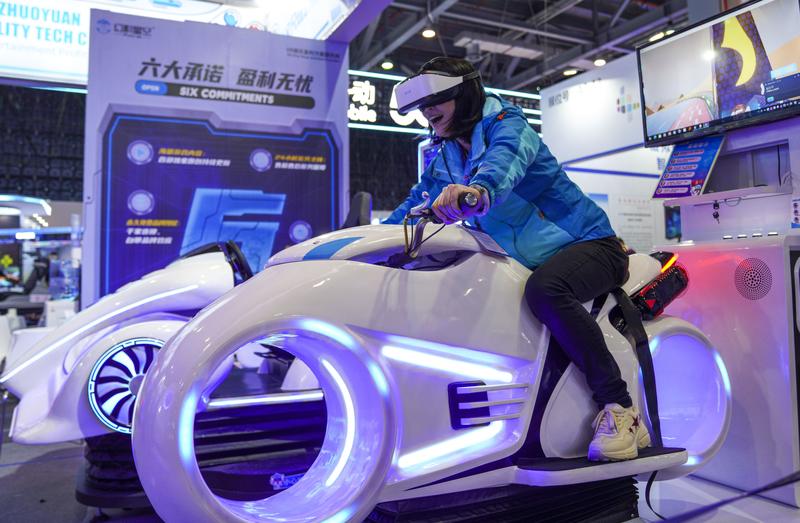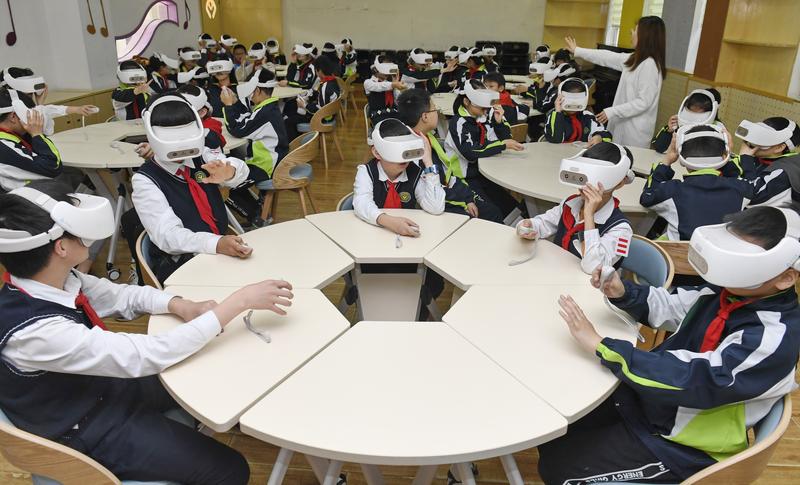Better experience, new applications driving growth
 An attendee experiences VR motorcycling at the 2021 World Conference on VR Industry in Nanchang, Jiangxi province, on Oct 19. (SHI GANGZE / FOR CHINA DAILY)
An attendee experiences VR motorcycling at the 2021 World Conference on VR Industry in Nanchang, Jiangxi province, on Oct 19. (SHI GANGZE / FOR CHINA DAILY)
The virtual reality and augmented reality industry has ushered in new development opportunities as a string of tech heavyweights are highlighting the significance of building what is known as the metaverse.
The term is one of the hottest buzzwords for the next phase of the internet, where the virtual world and the physical world are becoming ever more interconnected, industry analysts said. A metaverse can mean virtual worlds shared by users, or digital spaces augmented by VR and AR technology.
The development of superfast 5G will have positive impacts on the VR and AR sectors, especially in education, healthcare, entertainment and telecommuting
Claire Zhao, an analyst at global market research firm IDC
The term metaverse was coined by science fiction writer Neal Stephenson of the United States in his 1992 novel Snow Crash. Both VR and AR technologies are fundamental components, as well as key drivers of the metaverse, and related supporting equipment can deliver an immersive, breathtaking and surreal interactive experience to consumers.
According to a report released by global market consultancy International Data Corp, a total of 2.2 million AR and VR headsets were shipped globally during the second quarter, skyrocketing by 126.8 percent compared with the same period last year.
Looking ahead, IDC expected VR shipments in 2021 to reach 8.4 million units and, by the end of 2025, to balloon to 26.7 million shipments, with a compound annual growth rate of 36 percent.
Much of this growth will be driven by additional consumers purchasing newer headsets such as the next generation of the PlayStation VR as well as the proliferation of application scenarios outside of gaming, such as virtual events and fitness, the report said.
VR headsets are seeing strong growth in 2021 from both consumer and commercial buyers, said Tom Mainelli, group vice-president for IDC's augmented and virtual reality team.
"We expect VR growth to continue well into the future as more consumer and enterprise use cases present themselves. Today, AR headsets are primarily focused on enterprise use cases, but we do anticipate consumer-focused headsets will gain traction in the later years of our forecast as major technology companies enter the space with new products.
"As companies continue to plan for a future that encompasses a combination of both in-person and remote work, we see VR playing an increasingly important role in driving next-generation collaboration, training and digital events," he said.
Some tech giants have jumped on the metaverse bandwagon and invested heavily in state-of-the-art VR and AR technologies. Chinese tech behemoth ByteDance, the owner of popular short video-sharing app TikTok, made its first foray into VR by acquiring Pico, a Chinese VR headset maker, in August.
ByteDance said Pico's comprehensive suite of software and hardware technologies, as well as the talent and the deep expertise of its team, will support their entry into the VR space and long-term investment in this emerging field.
 Students experience VR scenarios wearing VR glasses at a primary school in Chengdu, Sichuan province, in April. (LI XIANGYU / FOR CHINA DAILY)
Students experience VR scenarios wearing VR glasses at a primary school in Chengdu, Sichuan province, in April. (LI XIANGYU / FOR CHINA DAILY)
Founded in 2015, Pico became the world's third-largest VR headset maker in the first quarter, with its shipments surging 108.6 percent year-on-year, while Facebook's Oculus led the global VR headset market, according to IDC.
Pico completed its B and B+rounds of financing in March, raising 435 million yuan ($68.1 million), and released a new generation of VR all-in-one machine, the Pico Neo 3, in May.
ByteDance is not the first technology giant that has acquired a VR startup. In 2014, social media titan Facebook purchased VR gaming company Oculus for about $2 billion. Other companies have also made inroads into the VR market-Apple Inc bought VR startup NextVR last year in what was reported to be a $100 million deal.
VR technology blurs the line between the digital and physical worlds, generating a sense of being present in a virtual environment. According to a report from global consulting firm Mordor Intelligence, the global VR market was valued at $17.25 billion in 2020, and the figure is expected to reach $184.66 billion by 2026.
Consumers are making wide use of VR applications based on different purposes, such as the automobile, gaming and media and entertainment industries, the consultancy said. The latest technologies across the consumer electronics segment are boosting the growth of VR in multiple applications across the marketplace, it added.
Statistics from Beijing-based market research firm CCID Consulting showed that the market size of China's VR industry reached 41.35 billion yuan in 2020 and is expected to reach 105.16 billion yuan in 2023.
The country will foster emerging consumption models such as 5G plus VR/AR and immersive gaming and promote the integration of 5G technology into life services, the Ministry of Industry and Information Technology said in January. VR and AR devices will benefit massively from 5G's high bandwidth and speed of transmission.
The ministry will also speed up the integration of VR with 5G, ultrahigh definition video and artificial intelligence, strengthen international exchanges and cooperation in the VR field and jointly explore new areas to bolster technological advancement.
"VR is a technology that has the potential to fundamentally transform people's lives, and 2021 will be the year people look back on as the year it really started to take off," said Alvin Graylin Wang, president of HTC China.
As a global innovator in smart mobile devices and VR technology, HTC Corp is accelerating steps to build a VR ecosystem, which includes VR headsets, software and content, as it aims to improve business and consumer VR.
Since the launch of its first VR product in 2016, industry insiders say, HTC has provided a hardware lineup to help enterprise users and consumers see the potential of XR, or extended reality, as the next-generation computing platform.
Extended reality is a term referring to all real-and-virtual combined environments and human-machine interactions generated by computer technology and wearable devices. It includes AR, VR and mixed reality or MR.
HTC has recently launched a pair of virtual reality glasses, the Vive Flow, which the company says allows users to enter a range of immersive experiences, such as connecting wirelessly to 5G-compatible Android smartphones and streaming content like TV shows and films from their favorite platforms.
In May, the company unveiled two new VR headsets. The company says the Vive Pro 2 is designed to push the boundaries of PC VR in gaming, creating and experiences, while the Vive Focus 3 is designed to set a new mark in business VR as a purpose-built all-in-one device.
In addition, HTC Vive, a virtual reality brand of HTC Corp, and Migu Co Ltd, a subsidiary of China Mobile that provides digital content and services, announced in September they will jointly build a 5G-powered, high-quality XR content ecology that will be a world leader.
"As the market enthusiastically embraces the new wave of metaverse, consumers' demand for mobile VR devices and unique experience related to VR will continue to rise," said Lin Junwu, president of HTC Vive content and platform. Lin added they will explore more diversified VR content, virtual entertainment experience and virtual social networking.
HTC has launched Viveport, a VR subscription service platform and an app store featuring a wide range of VR content and experiences, covering sports, education, arts, social networking, games and videos. It supports a wide range of VR headsets including PC, stand-alone and mobile devices.
He Lizhong, an analyst from Capital Securities, said VR/AR is considered to be the core application scenario of 5G in the future and one of the most important end-use products after smartphones.
Superfast 5G mobile network technology also represents an opportunity to accelerate the adoption of AR and VR by shoppers and marketers.
"We expect that the implementation of 5G and AR/VR in stores will transform not only customer engagement but also the entire product management cycle of brands," said Sylvain Fabre, senior research director at market consultancy Gartner.
Still, some important industry-wide challenges remain, experts said.
More efforts should be made to improve VR-related hardware devices and strengthen content production so as to cut the costs of research and development as well as build a complete VR ecosystem, industry insiders said.
Claire Zhao, an analyst at IDC, said some internet-based companies have made forays into the VR/AR sector, which has broad application prospects in the fields of gaming, online social networking and fitness.
"The development of superfast 5G will have positive impacts on the VR and AR sectors, especially in education, healthcare, entertainment and telecommuting. We still feel optimistic about the future of VR and AR. The compound annual growth rate of China's VR and AR market over the next five years is expected to be 67.5 percent, but it will take some time to be widely accepted by the public," she said.
Zhao said that at present, most VR hardware manufacturers are startups with insufficient capital, and therefore they have run into difficulties in content creation. But she said that the costs along the entire industry chain are expected to be reduced as more VR devices are shipped in the future.


